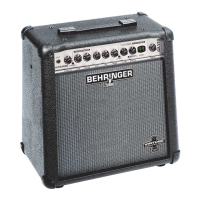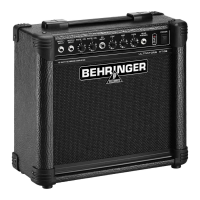ULTRA-G GI100
8
This diagram illustrates two standard DI applications. The signal going to the
amp via the DIRECT LINK is unaffected; it is simply picked up and additionally
fed, as a balanced, low-impedance signal, to the mic inputs of the mixing
console. This is particularly advantageous with bass guitars, since micro-
phones that reproduce high-energy bass frequencies in a halfway linear
manner are rareand expensive. When using effects or other outboard
processors, these should be connected in front of the ULTRA-G in the signal
path, so that its output includes these signals.
Few keyboards have balanced outputs. Here, a quality DI box such as the
GI100 is indispensable to ensure clean signals, especially when using long
cables.
2.3 Converting a microphone signal from high-impedance unbalanced
to low-impedance balanced
Many inexpensive microphones have unbalanced high-impedance outputs.
With the ULTRA-G, these microphones can be used in spite of long cable runs
without the danger of hum or other interference. Simply insert the GI100
between the microphone and the console. For this application, you will most
likely want to switch the VIRTUAL CAB speaker simulation off.
2.4 Picking up a signal from a loudspeaker output
There are times when picking up a signal after amplifier processing is desirable
to achieve a certain sound, but no direct out is available. Thanks to the GI100s
two -20 dB PAD switches, you can feed a console from the loudspeaker output
of an amplifier with a power rating of up to 3,000 Watts (4 Ohm) without
overloading the ULTRA-G. When using a tube amp, be sure to connect a
speaker or other impedance load to the DIRECT LINK output. We recommend
using the VIRTUAL CAB speaker simulation in these applications, when signals
from electric guitars are transmitted.
2. CONNECTION EXAMPLES
DATA-MANFULL_GI100_ENG_Rev A.p65 07.09.01, 15:438

